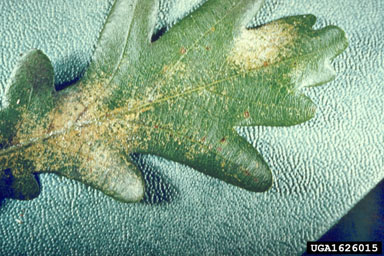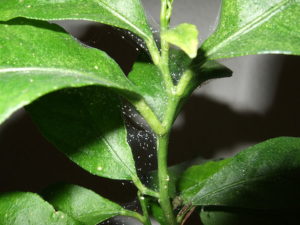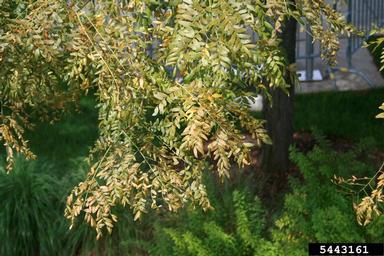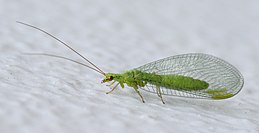
Oak spider mites (Oligonychus bicolor) may be hard to see with the naked eye but they are a serious pest for homeowners and if left untreated can kill your Oak trees. Classified as arachnids, these tiny bugs are less than 1/20 inch long when fully mature and look like moving dots to the naked eye. Despite their size, our arborists warn that mites can be a huge problem for homeowners, especially in the hot days of late summer.
When temperatures are over 80 degrees, oak spider mites reproduce rapidly. This allows large populations to develop and damage your tree severely before you even notice the symptoms. On top of that, oak spider mites spread throughout you and your neighbor’s property easily. Once one plant is infected, mites use the wind and their webbing to easily sail from one tree or shrub to another.
It’s possible your tree will survive this year’s spider mite infestation without too much damage; however, it will still be in danger. Trees that are infested this summer will become infested next year as well. This is because oak spider mites lay eggs that overwinter on the infested tree and hatch in spring. Repeated infestations can severely damage even the strongest of oak trees causing an overall decline in health and possibly the death of the tree. Learn what signs to look out for and how to keep them from destroying your landscape.
Symptoms Of Oak Spider Mites:
Spider mites cause damage by sucking cell contents from the leaves. You most likely will not notice anything odd when mites are at low populations; however, when they continue to grow to a high population you will start seeing the damage.
- Stippling of light dots on leaves
- Leaves turning yellow or reddish
- Leaves dropping off
- Webbing covering leaves and twigs
- Tiny moving dots on the underside of leaves (what these mites look like to the naked eye)



Bronzing foliage symptoms on spider mite affected honeylocust
Trees Susceptible To Spider Mites:
Most tree species are plagued by spider mites and in fact, many even have their own species. For example, Maples are plagued by Maple Spider Mites and Honeylocust by Honeylocust Spider Mites.
Oak Spider Mites in particular attack all types of Oaks; however, pin oaks and willow oaks tend to be the most susceptible. Despite the name, these mites can also be found on birch, beech, elm, and hickory trees.
Treatment For Oak Spider Mites:

Organic Control Through Beneficial Insects:
Spider mites have many natural enemies including, predatory mites, minute pirate bugs, and lacewing larvae. We can release these predators on your property in order to control the population of these mites. This is a great option for homeowners that are worried about chemicals on their property or have kids that would love to be involved in releasing the bugs on the property. Learn More About Beneficial Insects.
Miticides:
High populations of Oak Spider Mites can be controlled by applying Miticides. Typically used as a foliar spray, miticides, can help bring the Spider Mite population back into control and can be used in conjunction to prevention and organic strategies.
Horticultural Oils:
Depending on the type of tree and the population levels, our arborist may recommend horticultural oils during the dormant season to kill any overwintering eggs.
Prevention:
Spider mites prefer hot, dusty conditions. Plants that are not watered enough and are experiencing drought stress are most susceptible. So make sure your trees and shrubs get enough water during the upcoming hot summer days. Mulching can also help your tree retain water. Watering and mulching your Oaks correctly and keeping them healthy overall is your first step in combating oak spider mites. To water and mulch correctly follow our tips below.
Watering:
- Focus on the critical root zone when watering. Wetting foliage is a waste of water and can promote the spread of diseases.
- DON’T use a sprinkler. This only wets the top layer of soil and doesn’t properly water the tree.
- Water in the morning to avoid evaporation and to help trees deal with the heat throughout the day.
- Water deeply and thoroughly 1 to 2 times a week.
- Put your normal hose somewhere in the critical root zone.
- Turn hose on to a dribble
- Leave for 2-3 hours
- Move the hose to a different spot in the critical root zone and leave for 2-3 hours. Repeat this step 1-3 times.
- You want the soil to be moist but not soaking. You should NOT be able to make a mud ball out of the soil.
- It’s okay for some portions of the soil to be wet and some to be dry.
Mulching:
Size: The best mulching goes out as far as the drip line of the tree. However, this isn’t reasonable for most homeowners with large trees. If mulching out to the dripline isn’t practical, apply mulch in a 2 to 3-foot radius around the tree instead.
Depth: About 2-4 inches
- Do not pile the mulch against the trunk of the tree. Instead keep the mulch away from the trunk, so that the root flare zone is visible.
- To refresh the look of mulch, lightly rake the top layers of the mulch, or simply remove the old mulch and replace with new mulch. Don’t pile new mulch on top of old mulch.
- Do not use fresh wood chips for mulching around young trees. Fresh wood chips have higher acidity and can injury a young tree.
If your tree is showing signs of Oak Spider Mites we can help! Give us a call at 703-573-3029 for a consultation or book an appointment through our online booking system. Our Certified Arborists will be able to diagnose your oak spider mite problem and develop a customized plan for your property.


